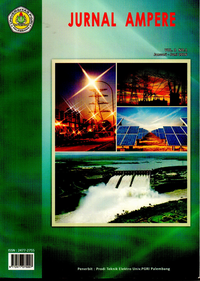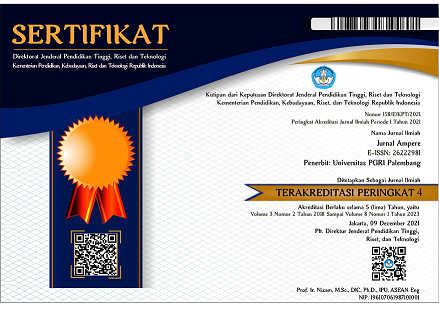MONITORING KUALITAS UDARA MENGGUNAKAN ROBOT SAMPAH
DOI:
https://doi.org/10.31851/ampere.v5i1.4306Keywords:
Polusi Udara, Kualitas Udara, Monitoring, MQ135, DHT22Abstract
Air pollution is a problem that still cannot been solved. Air pollution can occur due to the imperfect combustion from vehicle engines and or industrial processes that produce gases that are not good for health.  If the levels of gas compounds found in polluted air exceed normal limits, it can give bad impact to the health.  Therefore, this study aims to raise an awareness for the human about the importance of healthy air quality. By raising their awareness, they will be more concerned about health that canlead to the minimalization of the risk of inhalling dangerous air. This research offers a garbage robot that not only has functions as a garbage box, but also as an air quality monitoring device.  The monitoring system in this study is equipped with MQ135 sensor that functions as a detector of air pollution and a DHT22 sensor that functions as a detector of temperature and humidity. The monitoring system built in this study is also equipped with a long-distance communication system by utilizing the Blynk application. The results of air quality monitoring in this study will show three conditions of air quality, namely: good, moderate and bad.  By having the information provided by the garbage robot in this study, the public can find out the condition of the air quality at that site. This system, of course, is very beneficial for humans. With the information of air quality, people can find out whether the place is safe or dangerous to their health.
ABSTRAK Polusi udara merupakan permasalahan yang sampai sekarang masih belum bisa terselesaikan. Polusi udara dapat terjadi akibat adanya pembakaran yang tidak sempurna dari mesin kendaraan maupun proses industri yang menghasilkan gas-gas tidak baik bagi kesehatan. Senyawa gas yang terdapat pada udara yang terpolusi dapat berdampak buruk bagi kesehatan apabila kadarnya melampaui batas normal.  Oleh karena ini, penelitian ini bertujuan untuk meningkatkan kesadaran tentang pentingnya kualitas udara yang sehat, sehingga masyarakat akan lebih peduli tentang kesehatan dan dapat meminimalisir risiko menghirup udara berbahaya. Pada penelitian ini ditawarkan sebuah robot sampah yang tidak hanya berfungsi sebagai kotak sampah, namun juga sebagai alat monitoring kualitas udara. Sistem monitoring pada penelitian ini dilengkapi dengan sensor MQ135 yang berfungsi sebagai pendeteksi polusi udara dan sensor DHT22 yang berfungsi sebagai pendeteksi suhu dan kelembapan. Sistem monitoring yang dibangun pada penelitian ini juga dilengkapi dengan sistem komunikasi jarak jauh dengan memanfaatkan aplikasi Blynk. Hasil monitoring kualitas udara pada penelitian ini akan menampilkan 3 kondisi kualiats udara di sekitar, yaitu: baik, sedang dan buruk. Dengan adanya informasi yang diberikan oleh robot sampah pada penelitian ini, masyarakat dapat mengetahui kondisi kualitas udara di tempat tersebut. Hal ini tentu saja sangat bermanfaat bagi manusia. Dengan adanya informasi tersebut, manusia dapat mengetahui apakah tempat tersebut aman ataukah berbahaya bagi kesehatan mereka
References
WHO, “A wealth of information on global public health,†2014.
WHO Regional Office for Europe, “WHO guidelines for indoor air quality,†Nutr. J., vol. 9, p. 454, 2010.
J. Sun, J. Mei, H. Li, and J. Shi, “Reschedule Your Travel Plans : Human Health and Air Pollution,†J. Travel Res. SAGE, no. 11, 2018.
S. Tian, T. Liang, and K. Li, “Fine road dust contamination in a mining area presents a likely air pollution hotspot and threat to human health,†Environ. Int., vol. 128, no. April, pp. 201–209, 2019.
A. De Marco et al., “Impacts of air pollution on human and ecosystem health , and implications for the National Emission Ceilings Directive : Insights from Italy,†Environ. Int., vol. 125, no. November 2018, pp. 320–333, 2019.
T. Cieplak, T. Rymarczyk, and R. Tomaszewski, “A concept of the air quality monitoring system in the city of Lublin with machine learning methods to detect data outliers,†vol. 03009, 2019.
N. Ullah et al., “Optimal Real-time Static and Dynamic Air Quality Monitoring System,†vol. 13, no. January, pp. 91–102, 2020.
A. S. Mih, “Evaluating air quality by combining stationary , smart mobile pollution monitoring and data-driven modelling,†2019.
V. Rao, “SmartAIR : Smart energy efficient framework for large network of air quality monitoring systems,†2019.
Y. Wang, “Mobile Solutions to Air Quality Monitoring,†pp. 1–11.
A. S. Handayani, N. L. Husni, R. Permatasari, and C. R. Sitompul, “Implementation of Multi Sensor Network as Air Monitoring Using IoT Applications,†in 34th International Technical Conference on Circuits/Systems, Computers and Communications, ITC-CSCC 2019, 2019.
N. L. Husni, A. Silvia, S. Nurmaini, and others, “New Challenges in Air Quality Sensing using Robotic Sensor Network,†Int. Conf. Innov. Eng. Technol., pp. 236–239, 2013.
M. Annisah, N. L. Husni, T. Dewi, and R. M. A. Rachmawati, “Peat Land Fire Monitoring System Using Fuzzy Logic Algorithm,†vol. 8, no. 3, pp. 181–188, 2019.
Downloads
Published
How to Cite
Issue
Section
License

Jurnal Ampere is licensed under a Creative Commons Attribution-ShareAlike 4.0 International License.
Authors who publish with this journal agree to the following terms:
- Authors retain copyright and grant the journal right of first publication with the work simultaneously licensed under a Creative Commons Attribution License that allows others to share the work with an acknowledgement of the work's authorship and initial publication in this journal.
- Authors are able to enter into separate, additional contractual arrangements for the non-exclusive distribution of the journal's published version of the work (e.g., post it to an institutional repository or publish it in a book), with an acknowledgement of its initial publication in this journal.
- Authors are permitted and encouraged to post their work online (e.g., in institutional repositories or on their website) prior to and during the submission process, as it can lead to productive exchanges, as well as earlier and greater citation of published work.






